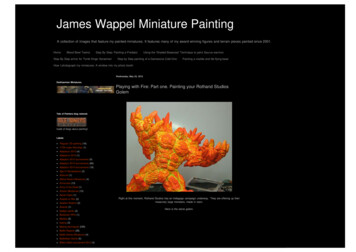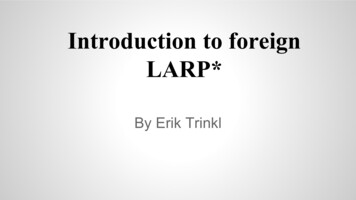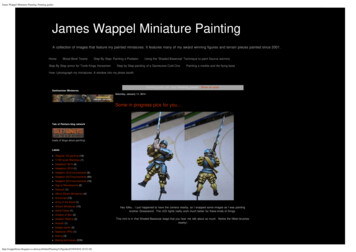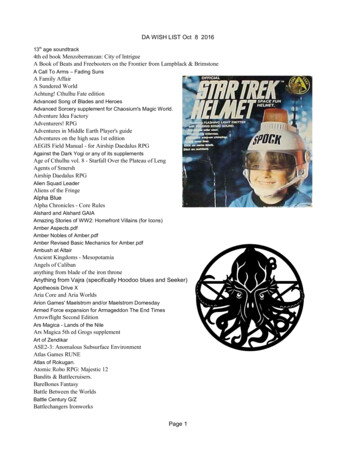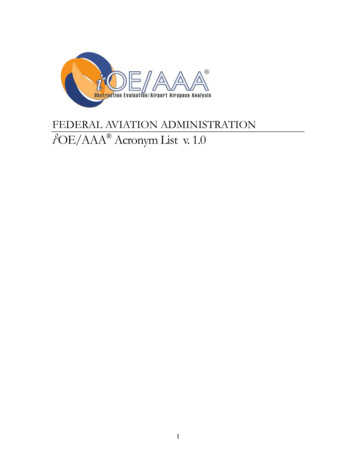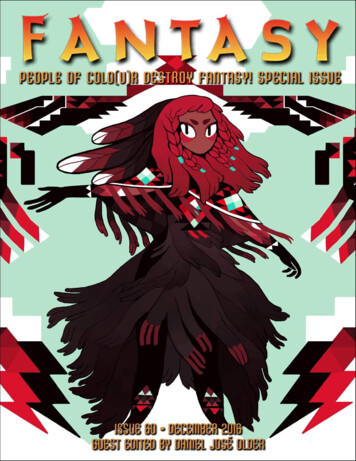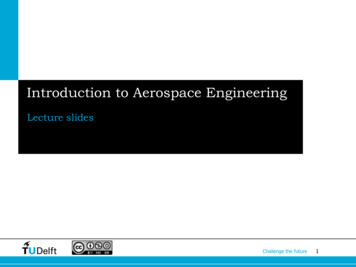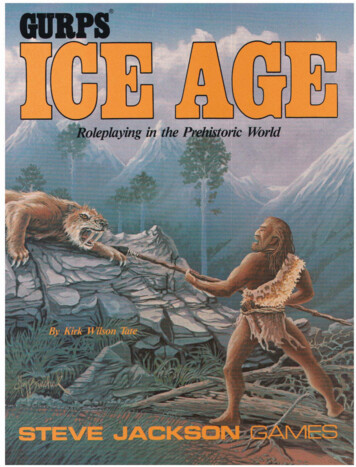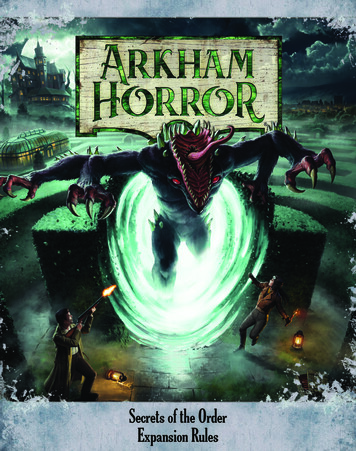
Transcription
CoverSecrets of the OrderExpansion Rules
Expansion OverviewSecrets of the Order is an expansion to Arkham Horror thatbrings the investigation back to the classic neighborhoodof French Hill and beyond our reality to the terrifyingUnderworld. As one of Arkham’s oldest areas, FrenchHill is home to ancient secrets, potential allies, andmysterious threats. Meanwhile, in the deepest layer of theDreamlands, beyond the veil of the waking world, theUnderworld is a realm of monsters and madness, whereonly the very desperate dare to roam.Secrets of the OrderThe stone figure glowered at Agatha Crane while she adjustedthe dials on her portable radio receiver. No plaque or recordrevealed the subject’s identity, but the statue excavated fromthe burned ruin of Bayfriar’s Church was deemed importantenough for pride of place in the conservatory that stood wherethe church once did. As crackling static gradually gave wayto a thin, incoherent voice, she carefully recorded the radiofrequency and consulted her notes. There was a presence here,lurking beyond perception, trying to be heard. Did its silentscreams carry a threat—or a warning?***Winifred Habbamock wrinkled her nose and slippedunnoticed into the Lodge’s cloakroom. The smell offrankincense and mothballs clung to everything, but evenso, she selected a heavy robe bearing the crest of the Orderof the Silver Twilight, with a hood to cover her face. Thesebluebloods played their cards close to the chest, but Winihoped to join tonight’s secret meeting and find out what theyknew. There was something looming on the horizon. Shewas going to stop it, and the Order was going to help her—whether they realized it or not. How hard could it be to speakLatin, anyway?This expansion features three replayable scenarios withbranching stories, new map tiles and locations, fourinvestigators with unique abilities and starting cards,and an assortment of assets, encounters, conditions,and monsters. Secrets of the Order also introduces severalmechanics, including new monster abilities and differentencounter types.Using This ExpansionWhen using Secrets of the Order, add the expansion’scomponents to your Arkham Horror collection as follows: Add the investigator and scenario sheets, investigatorstandees, map tiles, and all tokens to their respectivesupply or pool. Shuffle the encounters, headlines, allies, items, andspells into their respective decks. Sort the archive, special, starting, condition, andmonster cards into their respective decks. Separate the anomaly and event decks for use asinstructed in each scenario. Do not mix the eventcards into the encounter decks.Expansion IconCards and sheets in this expansion aremarked with the Secrets of the Orderexpansion icon to distinguish them frommaterial from other Arkham Horrorproducts.2
Components1 Mystery Tile2 NeighborhoodMap Tiles1 Anomaly TokenBoundW in iFred habbaMockT h e a v iaTrixto“Any one you walk away from, right?”Starting SpaceFocus Limit: 36124242 Threshold Tiles1 Hidden Path and1 Derelict Portal/Bridge StreetServeThe Story So Far.A plague of unquiet spirits washes overArkham, creating a psychic disturbancethat cannot be ignored. Sealed by anancient pact, these lost souls must befreed from the ancient evil that bindsthem.Just That Good—Once per round, whenyou would fail a test, you may spend onefocus to roll one additional die. If you failthat test, choose a skill that you do nothave focused; focus that skill twice.The Witch House6ReckoningLoreInfluenceFor each spirit monster, place onedoom in its space. If there are nospirit monsters on the board,spawn one spirit monster.ObservationStrengthWill4 Investigator SheetsWith 4 matching tokens and plastic stands3 Scenario Sheets121 Nightmare PlagueRumors trickle in of strange sightings andsupernatural occurrences all across town.The long departed appear once more, twistedcaricatures of their former selves, enthralled toa dark power. Nightmarish apparitions andinexplicable chaos surge through the streets.You must find the cause of this disturbance andlet these poor souls find rest once more.When an investigator would gain a clue,instead place that clue on this card andplace one random set-aside Lodge monsteron the bottom of the monster deck. Thenif there are two clues on this card, discardthose clues and flip this card.When there is three or more doom on thescenario sheet, add card 124 to the codex.(Do not remove this card from the codex.)FrenderworldncThehldhohsillThrUes1214 Headline CardsHn Houndntin g DtaauCoursingdy TiMonsteaBloog er —Monster——GuHoundof TroTindalos dMonsterubled Spirit2*–Spawn att prey.resspace.unneaSpawnat eetunstablestablestrspavece.n atawsivSpElue. Shrou directlyMotor—Place onHunter—Moveand.dedHunte. Luestrke ssivee.dor—omMaengageagehighest .inlowengthis space.toward and20 Monster Cards45 Archive Cards12 Anomaly Cards80 Event CardsFrenderworldncThehldhohsillThrUes54 Encounter Cardsd D rivenFatiguedFa tig ueCond itioConditionnnCond itiot card.YourdiscarfocdiscardIf you are driven,card.usd thaitthatdriveincn,reased limanisas as, onIf you areWhileabytest,an reAtolving a testore.moresresolvingendiletheofrerrerollWhareoll costhatt ttest.added,oneyouthioves card tomaionye, remyouus actdicWhenform aperperformafocfocusaddmactionfornalcarsonitiopere d.d thicaracten youdriven,ionorWhbecomediscardn, dis.this card.ivedreor becomAgatha CraneThe Parapsychologist 6 Condition Cards2 Marker Tokens7 Asset Cards12 Starting Cards18 Special Cards20 Focus Tokens3
Expansion RulesMap TilesTreat threshold spaces as street spaces for all effects, withthe exception of encounters.Threshold EncountersSecrets of the Order introduces two types of threshold tiles,two hexagonal neighborhood tiles, and one mystery tile.Threshold TilesThresholds represent portals between our world and otherplaces beyond our ken. They feature hazardous borders, asdescribed later on this page. When one or more thresholdtiles enters play, either during game setup or as a result ofa codex effect, shuffle the threshold encounter deck andput it into play near the other encounter decks. When athreshold tile is added to the map, orient the hazardousborders randomly. Hidden PathsHidden paths are unpredictable andcapricious routes between worlds. Thehidden path tile is a corner tile thatconnects to the corners of the hexagonalneighborhood tiles. The borders on the tile indicate that thehidden path space is adjacent to the locations it abuts, andinvestigators and monsters may move across that border.ThresholdsThresholds have their own encounterdeck. During the encounter phase, if aninvestigator is in a threshold space andthey are not engaged with a monster, theydraw a card from the threshold encounterdeck and resolve the effect that matchesthe type of threshold space they are in, asindicated by the icon in that space.Other WorldsThe Underworld is an other world tile, and featuresthe other world nameplate, to allow it to be easilydistinguished from other types of neighborhood tiles.Hazardous BordersOther worlds are dangerous, nightmarish places, andtraveling through them is no simple task. Moving fromone space to another in other worlds or thresholds cancarry an additional cost, indicated by icons on the borderlines that separate some spaces. These special borders arecalled hazardous borders, and after an investigator movesacross one such border, they must immediately stopmoving unless they pay an additional cost, as indicated bythat border’s icon.Damage: After you cross a damage border, youmust stop moving unless you suffer one damage.Example: Agatha Crane is on a hidden path and wishesto move one space. She can move to the Train Station, thePolice Station, or the City of the Gugs. The street space doesnot share a border with the hidden path, so she cannotmove there directly from the hidden path. Derelict PortalsDerelict portals are mystical doorways todistant realms, tucked away in the darkcorners of our world, where they remainunseen by ordinary folk. Like streets,derelict portals connect two hexagonal map tiles. Wild GatewaysWild gateways are dangerous and unstable tears in reality.Although this encounter type appears on the thresholdencounter cards in Secrets of the Order, wild gateway maptiles appear only in other expansions.4Horror: After you cross a horror border, youmust stop moving unless you suffer one horror.Focus: After you cross a focus border, you muststop moving unless you discard one focus token.Monsters ignore the additional costs for crossinghazardous borders, and instead move as normal.Example: As his move action,Preston Fairmont moves froma derelict portal to the Vale ofPnath and crosses a damageborder (1). He wishes tocontinue his movement, so hesuffers one damage. Then hemoves to the Vaults of Zin,crossing a focus border (2).Because Preston is not movingany further, he need notdiscard a focus token.21
Mystery TilesGate BurstsMysteries are places of power and madness that offerencounters that are more rewarding, yet more dangerous,than those found in other locations. There are twomysteries included in Secrets of the Order: the WitchHouse and the Unnamable. These single-space endcaptiles are added to the game board as indicated by somescenario setup maps.When you resolve a gate burst in an expandedneighborhood, including when the gate burst resolves inthe mystery space itself, place one doom in each of threedifferent spaces in that neighborhood, instead of onedoom in each space in that neighborhood.A mystery is adjacent to any other space with which itshares a border. Investigators and monsters can move intomystery spaces as they would any other space.Because mystery locations have their own encounter decks,when a clue spawns at a mystery, place that clue in themystery space and shuffle the event card into the top twocards of the mystery encounter deck. Clues at a mysterylocation can be gained via an encounter in that space,not via encounters in other spaces in that neighborhood.When you are at a mystery location, if an effect indicatesthat you would gain a clue from your neighborhood, gainthat clue from the mystery space you occupy instead.Each mystery has a corresponding encounter deck.During the encounter phase, if an investigator is in amystery space and they are not engaged with a monster,they draw and resolve an encounter card from thatmystery’s deck.Expanded NeighborhoodA mystery tile is part of the neighborhood to which it isconnected. If an effect places doom in a mystery space,that doom is counted with the rest of the connectedneighborhood for the purpose of resolving any effectsthat count the total number of doom tokens in thatneighborhood, such as anomalies. Similarly, if aneffect references clues, monsters, investigators, or othercomponents in a neighborhood with a mystery, that effectreferences components at that mystery as well (with theexception of gate bursts, as described in the next column).Example: The Unnamable mystery is connected to theMerchant District neighborhood, and archive card 2 is inthe codex, adding the anomaly rules to the game. Thereis two doom each at the Unnamable and the UnvisitedIsle, when an effect places another doom at the RiverDocks. Because the Unnamable is part of the MerchantDistrict neighborhood, there is now a total of five doomin that neighborhood, causing an anomaly to open in theMerchant District.Clues on MysteriesComplex EncountersUnlike other location and street encounters, mysteryencounters provide divergent paths that depend on thechoices that the investigator resolving that encountermakes. Each mystery encounter card contains threesections of effect text for the same location.To resolve a mystery encounter, first resolve the top effect,which offers a choice regarding how to proceed; eachoption is presented in bold type. Then, refer to the othertwo effects and resolve the effect under the header thatmatches that choice. Do not read the secondary effectsbefore the investigator encountering the mystery makestheir choice.Example: During an encounter at the Witch House, MarkHarrigan finds an unusual journal, and the first effectends, “You may read the first entry or the last entry inthe journal.” He chooses the latter option, and resolves thebottom effect, with the header, “Last Entry.”5
MonstersSecrets of the Order introduces the following keywords andabilities that present new ways for monsters to behave.Monster MovementMonsters ignore the additional cost to cross hazardousborders, and instead move as normal. (See page 4.)Attack ModifiersSome new monsters display skills other than as partof their attack modifier. When an investigator performsan attack action against a monster, they test the skillindicated by the attack modifier. Items and other effectsthat provide bonuses to do not provide that bonusif the investigator is attacking with a different skill.However, assets and abilities that grant a bonus to may have other effects as well, which can be used asnormal while performing an attack action against amonster with an alternate attack modifier.Example: Jenny Barnes attacksa Lodge Seer, who has an attackmodifier of –0. Jenny’s lore isone, and her weapon, Jenny’s Twin.45s, grants her a bonus whenshe attacks using . That bonusdoesn’t apply, so she rolls only onedie while performing an attackaction to attack the Lodge Seer.She can still use the weapon’s othereffect to add one to the result of asingle die.ShroudedWhen a monster with the “shrouded”keyword is ready, it cannot be exhausted andinvestigators cannot look at the engaged/exhausted side of that monster card. Inaddition to the keyword, shrouded monstersfeature the shrouded icon on their ready side.Shrouded IconWhile a shrouded monster is ready, it does not haveany of the attributes that appear only on the engaged/exhausted side of the monster card, including health;attack and evade modifiers; damage, horror; or any abilitytext, trait, or keyword that does not also appear on thecard’s ready side.A shrouded monster can be dealt damage while ready, butas it does not have a health value, it cannot be defeatedby that damage until it is engaged or exhausted. A readyshrouded monster can be defeated or discarded normallyby effects that do so without dealing damage.When a shrouded monster engages an investigator, it isimmediately defeated if it has already suffered damageequal to or exceeding its health. While engaged orexhausted, a shrouded monster can be defeated by damageas normal.When a shrouded monster would be discarded, shuffle itinto the monster deck instead.When a shrouded monster is placed during setup, randomlychoose one monster with the indicated name on the readyside and place it on the board without looking at theengaged side.Monster KeywordsNew keywords appear on some monsters in Secrets of theOrder. The rules for each keyword are detailed below.Reminder text is often printed where these keywordsappear to assist players with a summary of these rules.RetaliateAfter you perform an attack action while engaged with amonster that has the “retaliate” keyword, if you dealt nodamage to that monster as part of that action, it attacksyou. This occurs even if you successfully dealt damage to adifferent monster as part of that action.61EngageDiscard23Example: Agatha Crane uses the Shriveling spell to dealtwo damage to a Raging Poltergeist monster in an adjacentspace (1). Because it has the shrouded keyword, themonster has no health attribute while it is ready and so itcannot be defeated by this damage.During the monster phase, the Raging Poltergeist movesinto Agatha’s space and engages her (2). The monster cardflips to the engaged side and becomes a ConfoundingSpecter, revealing that its health is two. Because themonster has suffered damage equal to its health score, it isimmediately defeated, and does not attack Agatha (3).
Adding and Removing DiceSome effects require investigators to change the numberof dice in a test’s dice pool after that pool has been rolled.To add one or more dice to a test, roll the appropriatenumber of dice and add them to the pool, determiningsuccesses as normal. To remove one or more dice from atest, select the specified number of dice from the pool andset them aside. Those dice no longer part of the test; theycannot be rerolled, and are not included in the test result.Archive CardsEffects in some scenarios place archive cards into aninvestigator’s play area instead of adding them to thecodex. Archive cards in an investigator’s play area affectonly that investigator.After an effect discards an archive card from an encounterdeck without returning it to the archive, place thatcard on top of that encounter deck from which it wasdiscarded. If an effect discards multiple cards from anencounter deck, resolve the entire effect before placing thearchive card on top of the deck.Double-Sided CardsSome double-sided cards become a different card typewhen an effect causes them to flip. Such cards indicate theoriginal card type in parentheses on the reverse side.When such a card enters play, it enters play as the cardtype that matches the deck it came from, with theappropriate side up, and changes type when an effectcauses the card to flip. When such cards are discarded,they are returned to the appropriate deck for the originalcard type.Adding a Tile to the MapDuring a scenario, effects in the codex may instruct theinvestigators to add tiles to the map. Archive cards withsuch effects include a map that shows which tiles to addto the board, and where to place monsters, doom, orother components.When the investigators are instructed to add a tile to themap, shuffle the encounter deck for that neighborhoodand prepare it as described during setup (described in theRules Reference, entry 102.4).New ConditionsThe new driven and fatigued conditions are printedon opposite sides of the same card. Because these twoconditions have different names, investigators may haveboth conditions at the same time. Investigators are free tolook at both sides of these condition cards at any time.Modifying the Mythos CupWhen the investigators are instructed to remove a mythostoken from the game, select a token of the appropriatetype from those still in the cup, if able. Otherwise, selecta token of the appropriate type from those that have beendrawn from the cup, but not yet returned to it.When instructed to add a token to the mythos cup, addthat token directly to the mythos cup.Event DeckIf an effect would cause an investigator to take or discarda card from the event deck when there are no cards in thedeck, cancel that entire effect and place one doom on thescenario sheet instead. Then shuffle the event discard tocreate a new event deck.7
Quick ReferenceHazardous BordersThreshold EncountersDamage: After you cross a damage border, youmust stop moving unless you suffer one damage.Hidden PathDerelict PortalHorror: After you cross a horror border, youmust stop moving unless you suffer one horror.Wild GatewayFocus: After you cross a focus border, you muststop moving unless you discard one focus token.Shrouded MonstersMonsters ignore the additional costs for crossinghazardous borders, and instead move as normal.CreditsWhile a shrouded monster is ready, it cannot beexhausted and investigators may not look at theother side of that monster’s card. (See full ruleson page 6.)Expansion Design and Development:Philip D. Henry with Alexis DykemaArt Direction: Jeff Lee JohnsonProducer: Jason WaldenProduction Management: Justin Anger and Jason GlaweEditing: Andrea Dell’Agnese and Julia FaetaManaging Art Director: Tony BradtProofreading: Sam Gregor-StewartQuality Assurance Coordination:Andrew Janeba and Zach TewalthomasBoard Game Manager: Christopher Winebrenner-PaloVisual Creative Director: Brian SchomburgArkham Horror Story Review:Kara Centell-Dunk and Matthew NewmanSenior Project Manager: John Franz-WichlaczCreative Director of Story and Setting:Katrina OstranderHead of Studio: Chris GerberExpansion Graphic Design: Caitlin Ginterand Michael Silsby with Evan SimonetteGraphic Design Manager: Christopher HoschCover Art: Anders FinerMap Tile Art: Jokubas UogintasInterior Artists: William Whomas Arnold, Ryan Barger,Sara Biddle, Yoann Boissonet, Joshua Cairos, AlexanderChelyshev, Matthew Cowdery, Alexandre Dainche, EricDeschamps, Stanislav Dikolenko, Derek D Edgell, AuroreFolny, Quintin Gleim, Margaret Hardy, Ilich Henriquez,Rafal Hrynkiewicz, Aleksander Karcz, Roman Kendelic,Alexander Kozachenko, Adam Lane, Robert Laskey,Diana Martinez, Patrick McEvoy, Germán Nóbile, JohnPacer, Emilio Rodriguez, Shane Tyree, Andeia Ugrai, DerkVenneman, Magali Villeneuve, Jarreau Wimberly, AndreasZafiratos, Matt Zeilinger, and Kim Chi ZutynExecutive Game Designer: Nate FrenchPlaytesters: John Bagley, Alex Byers, Nate Carnahan,Emile De Maat, Josiah “Duke” Harrist, Anita Hilberdink,Jed Humphries, Alex Lupella, Josh McCluey, Erik Miller,Lacey Miller, Riley Miller, Calli Oliverius, BrandonPerdue, Angelic Phelps, Joe Phelps, Shiyue Xu, LéonTichelaar, Marjan Tichelaar-Haug, Jan van den Bosch,Vera Schaijk, and Veronica Gatica WiermannSpecial Thanks to all of our beta testers! 2021 Fantasy Flight Games. Gamegenic is TM & Gamegenic GmbH. Arkham Horror, Fantasy Flight Games, and the FFG logo are of FantasyFlight Games. Fantasy Flight Games is located at 1995 West County Road B2 Roseville, Minnesota 55113 USA 651-639-1905.Actual components may vary from those shown.8
hidden path tile is a corner tile that connects to the corners of the hexagonal neighborhood tiles. The borders on the tile indicate that the hidden path space is adjacent to the locations it abuts, and investigators and monsters may move across that border. Derelict Portals Derelict portals are mystical doorways to
